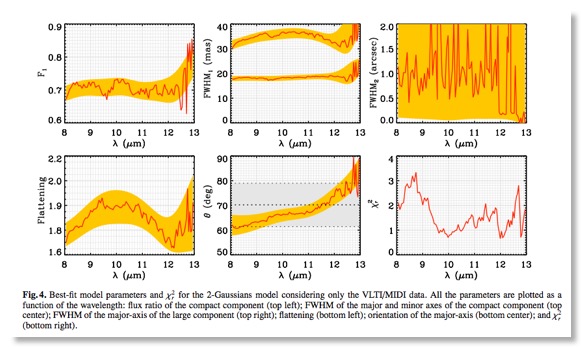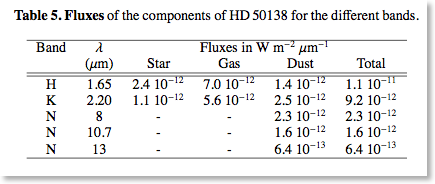I A possible new shell phase
by M. Borges Fernandes, M. Kraus, O. Chesneau, A. Domiciano de Souza, F.X. de Araujo, Ph. Stee, and A. Meilland 2009, A&A, 508, 309
The observed spectral variation of HD 50138 led different authors in the literature to classify it in a very large range of spectral types and luminosity classes (from B5 to A0 and III to Ia) and at different evolutionary stages, as either an HAeBe star or a classical Be.
Based on new high-resolution optical spectroscopic data from 1999 and 2007 associated to a photometric analysis, the aim of this work is to provide a deep spectroscopic description and a new set of parameters for this southern unclassified B[e] star and its interstellar extinction.
From our high-resolution optical spectroscopic data that are separated by 8 years, we perform a detailed spectral description, presenting the variations seen and discussing their possible origin. We derive the interstellar extinction to HD 50138 by taking into account the influences of the circumstellar matter in the form of dust and an ionized disk. Based on photometric data from the literature and the new Hipparcos distance, we obtain a revised set of parameters for HD 50138.
Due to the spectral changes, we tentatively suggest that a new shell phase could have taken place prior to our observations in 2007. We find a color excess value of E(B-V) = 0.08 mag and from the photometric analysis, we suggest that HD 50138 is a B6-7 III-V star. A discussion about the different evolutionary scenarios is also provided.










The galactic unclassified B[e] star HD 50138
II. Interferometric constraints on the close circumstellar environment
by M. Borges Fernandes, A. Meilland, P. Bendjoya, A. Domiciano de Souza, G. Niccolini, O. Chesneau, F. Millour, A. Spang, P. Stee and M. Kraus, 2011, A&A, 528, A20
HD 50138 is a southern star that presents the B[e] phenomenon, but its evolutionary stage is still not well known. This object presents spectral variability, which can be explained by outbursts or shell-phases. Spectropolarimetric observations have shown the presence of a non-spherically symmetric circumstellar environment that is responsible for the B[e] phenomenon. However, up to now, the structure of the circumstellar medium of this object was not deeply studied.
Based on recent optical long baseline interferometric observations from the VLTI/MIDI and VLTI/AMBER, and also from the Keck segment-tilting experiment, we study the structure of the circumstellar environment of HD 50138.
The analysis of our data is based on geometrical analytical modeling, also using the recent LITpro software and considering a large space of parameters, which allows us, to obtain a good estimate of the geometry of the circumstellar medium of HD 50138, responsible for the emission in the H, K and N-bands.
We resolve the circumstellar environment of HD 50138 and describe for the first time in details its geometry. Through the analysis of multi-wavelength data, the presence of a dusty circumstellar disk with an orientation onto the sky-plane of 71 ± 7°, which is perpendicular to the polarimetric measurements from the literature, was derived. We have also derived that HD 50138 is seen under an intermediate angle related to the line of sight, 56 ± 4°. In addition, a discussion concerning the structure of the disk and the flux contributions of the gas and dust components is provided.
Based on the analysis of different sets of interferometric data, we describe the presence of a circumstellar disk, whose geometric parameters were determined, allowing us to understand the geometry of the circumstellar material of this bright star with the B[e] phenomenon.





